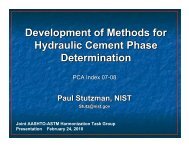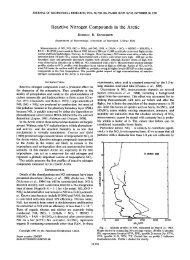Evaluation of Septic Tank and Subsurface Wetland for
Evaluation of Septic Tank and Subsurface Wetland for
Evaluation of Septic Tank and Subsurface Wetland for
Create successful ePaper yourself
Turn your PDF publications into a flip-book with our unique Google optimized e-Paper software.
The predominant geological <strong>for</strong>mations in Jamaica consist <strong>of</strong> White Limestone, Yellow<br />
Limestone <strong>and</strong> Volcanics (Smikle, 2000). Locations with porous soil structures allow<br />
raw sewage to empty into the groundwater table. The geometry <strong>of</strong> a wastewater<br />
infiltration system affects how well the water is dissipated <strong>and</strong> treated by the soils.<br />
Infiltration trenches that are long, narrow <strong>and</strong> shallow are preferred over wide beds <strong>and</strong><br />
deep pits. A biological mat <strong>of</strong> microbes <strong>for</strong>ms as wastewater flows into the soil. This<br />
mat <strong>and</strong> cover vegetation capture <strong>and</strong> consume the organics <strong>and</strong> nutrients making it<br />
possible <strong>for</strong> high reduction <strong>of</strong> biochemical oxygen dem<strong>and</strong> (BOD), total suspended solids<br />
(TSS), phosphorus, viruses <strong>and</strong> coli<strong>for</strong>m bacteria. The nitrate <strong>for</strong>m <strong>of</strong> nitrogen is not<br />
readily removed by soil so nitrate levels may be elevated under any system that does not<br />
adequately remove it prior to infiltration (USEPA, 2000). Although some biological<br />
activity is expected in a deep pit infiltration system such as the Jamaican absorption pit,<br />
the predominant geology <strong>and</strong> geometry are in no way favorable to adequate treatment.<br />
An absorption pit can be dug by h<strong>and</strong> or may require a jackhammer to break through<br />
large rocks or solid rock. If the walls <strong>of</strong> the excavation are not stable, rocks are stacked<br />
from the bottom up to create a wall <strong>of</strong> uncemented rocks lining the entire hole. Depths<br />
range from six to twenty feet <strong>and</strong> widths vary from five to eighteen feet with the top<br />
normally being the widest <strong>and</strong> tapering toward the bottom. Absorption pits are expected<br />
to fill up after years <strong>of</strong> use at which time another pit is dug. Some cover slabs are<br />
designed with a manhole so the septage can be pumped out when required. At present<br />
there are only two National Water Commission (NWC) waste treatment plants that<br />
regularly receive <strong>and</strong> treat septage.<br />
A natural variant <strong>of</strong> the absorption pit is a sink hole (locally called a “say ball” or “say<br />
bowl”) in the limestone that connects to an underground void or aquifer. Household<br />
sewage pipes are connected to such a hole which is then capped with concrete to create a<br />
permanent waste water disposal system. This eliminates the expense <strong>and</strong> labor <strong>of</strong> digging<br />
a pit <strong>and</strong> greatly increases the life <strong>of</strong> the sewage disposal system since it is unlikely that<br />
the sink hole will ever fill up.<br />
2








